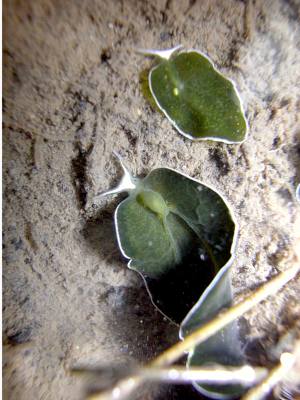
Elysia leucolegnote
Jensen, 1990
Order: SACOGLOSSA
Superfamily: ELYSIOIDEA
Family: Elysiidae
DISTRIBUTION
Known only from Hong Kong
PHOTO
Lantau Island, Hong Kong. Depth: 20cm. Length: approx 4cm. Photo: Ken Ching
The animal is very dark green with a white edge to the parapodia and a white triangular patch on the head which extends along the dorsal side of the rhinophores. The rhinophores lack branches of the digestive gland so are translucent clear rather than the green of the rest of the body. Jensen (1990) notes that this is a large species growing to at least 3cm long. Its parapodia are usually held open 'so the animal resembles a mangrove leaf'. The rhinophores are long, slender and grooved, rather than auriculate. The sole of the foot is divided anteriorly by a transverse groove. Jensen (1990) reports that it feeds on the filamentous green algae Boodleopsis pusilla, which forms a fine mat over the mud in small puddles in the mangrove swamp. One egg mass was produced in captivity. It was unusual for a sacoglossan, being a 5cm long string rather than the usual coil.
References:
• Jensen, K.R. (1990) Three new species of Ascoglossa (Mollusca, Opisthobranchia) from Hong Kong, and a description of the internal anatomy of Costasiella pallida Jensen, 1985. [In:] Proceedings of the 2nd International Marine Biological Workshop: The marine Flora and Fauna of Hong Kong and Southern China, Hong Kong, 1986. (Ed: Morton,B) Hong Kong University Press, Hong Kong, 419-432.
• Jensen, K.R. (1990) Feeding Behaviour of some Hong Kong Ascoglossa (Mollusca: Opisthobranchia). [In:] Proceedings of the Second International Marine biological workshop: The marine Flora and Fauna of Hong Kong and Southern China, Hong Kong, 1986. (Ed: Morton,B) Hong Kong University Press, Hong Kong, 961-978.
Rudman, W.B., 2003 (July 2) Elysia leucolegnote Jensen, 1990. [In] Sea Slug Forum. Australian Museum, Sydney. Available from http://www.seaslugforum.net/find/elysleuc
Related messages
Elysia anatomy again
July 16, 2003
From: Skip Pierce
Hi Bill,
Concerning your question, I don't think there is much in the literature about gas exchange per se in elysiids, especially comparing the integument with the circulatory system-although I might have missed it. Photosynthesis has been shown, carbon fixation and the appearance of photosynthetically fixed carbon in "animal" molecules (metabolites and mucus, as I recall)-- but the slugs are relatively small and worse, make so much mucus that doing much physiology or biochemistry on them is a real chore -- mucus everywhere.
Skip
pierce@cas.usf.edu
Pierce, S., 2003 (Jul 16) Elysia anatomy again. [Message in] Sea Slug Forum. Australian Museum, Sydney. Available from http://www.seaslugforum.net/find/10453Re: Elysia anatomy
July 15, 2003
From: Skip Pierce
Hi Bill
A quick comment with respect to your message last week about Elysia physiology. While the data are relatively few, if you shine a light on an Elysia and measure oxygen, you'll find that there is a net oxygen production. The symbiotic plastids produce (way) more oxygen than the animal consumes under daylight conditions. So it's possible that the vascularization on the dorsal surface is to get rid of excess oxygen, rather than take it up. You always have to think like a plant with elysiids.
Skip
pierce@cas.usf.edu
Thanks Skip,
Trying to simplify complicated issues can itself be complicated. I hoped I had covered this point by mentioning the removal of wastes and photosynthetic products. I assume the chloroplasts need a supply of oxygen when the sun [or light] is not on. Considering how close the chloroplasts are to the thin body wall, I wonder if much of the gas exchange [oxygen, carbon dioxide etc] is done directly through the body wall? Has any work been done to address this point?
Cheers,
Bill Rudman
Another Elysia leucolegnote from Hong Kong
July 6, 2003
From: Kathe Jensen
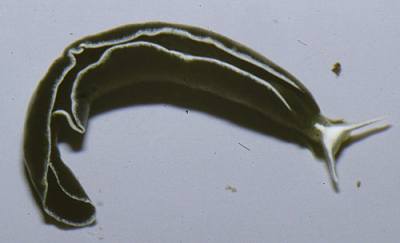
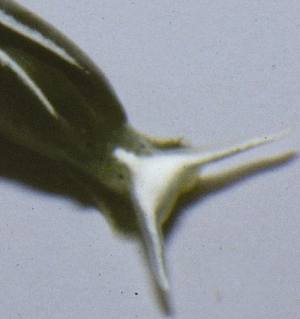
Dear Bill,
To acompany Ken Ching's photo, here is another picture of Elysia leucolegnote. It was collected in Ting Kok mangrove in Hong Kong, April 1986.
Greetings,
Kathe
KRJensen@zmuc.ku.dk
Jensen, K., 2003 (Jul 6) Another Elysia leucolegnote from Hong Kong. [Message in] Sea Slug Forum. Australian Museum, Sydney. Available from http://www.seaslugforum.net/find/10400Thanks Kathe,
Bill Rudman
Elysia leucolegnote from Hong Kong
July 3, 2003
From: Ken Ching
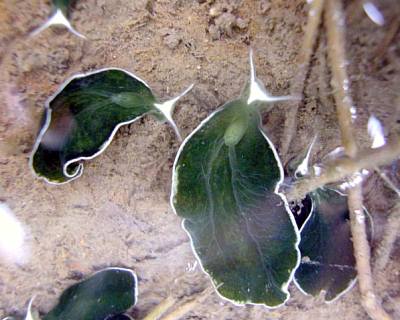
Dear Bill,
Hi, I am a diver in Hong Kong and I have found this sea slug on a wetland in HK. The information is as followed:
Location: Lantau Island in Hong Kong. Depth: 20cm. Length: about 4cm. We discovered more than 2000 at the same place
Dr. Andrew S. Cornish of HK University and Leslie Chan have helped me ID it as a species of Elysia and they both asked by to send you pic to confirm it. Thanks for your help.
Ken Ching
kenching1972@yahoo.com.hk
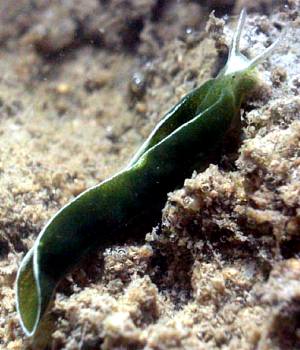

Dear Ken,
This is obviously quite common at times in Hong Kong. It has very distinctive white markings and long rhinophores [head tentacles]. Kathe Jensen has identified it for me as Elysia leucolegnote, a species she described from Hong Kong in 1990.
I have used one of your excellent photos in a separate message outlining some of the anatomical features you can see externally.
Best wishes,
Bill Rudman
Elysia leucolegnote - anatomy
July 3, 2003
From: Bill Rudman
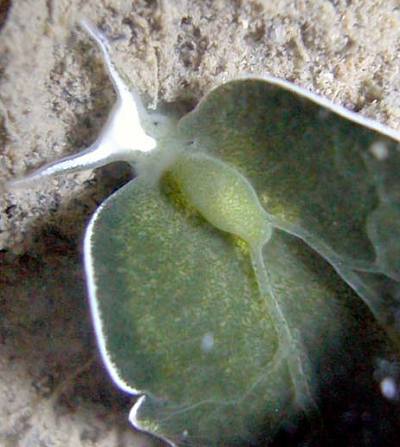
The photos in Ken Ching's message about Elysia leucolegnote from Hong Kong show some features of the external anatomy of an elysiid so well that I thought I would post a separate message showing some of these. Firstly many species of Elysia are part of a fascinating group of sea slugs which I have called Solar Powered. Many species of Elysia keep the photosynthetic chloroplasts from the plants they feed on, alive and functional in their own bodies, which in many ways have modified to resemble leaves. I am not sure if this species keeps the chloroplasts alive and functional in its body, but the fine green specks visible in the upper photo, suggests it does at least store them for a while. The whole of the wide, flattened leaf-like parapodia are filled with branching ducts of the digestive system, in which the chloroplasts are stored. The pericardium is a large blood-filled sac in which the heart is situated. Leading from the pericardium are a series of branching blood vessels, which are called veins or dorsal vessels by different authors. The parapodia need to be well-supplied with fresh blood because this area is now the main area of metabolic activity in the slug and so it needs a constant supply of oxygen and a means to remove waste products, and to carry the products of photosynthesis [sugars etc] to other parts of the body.
Best wishes,
Bill Rudman
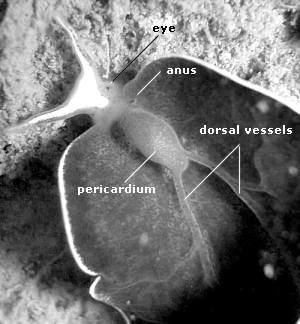
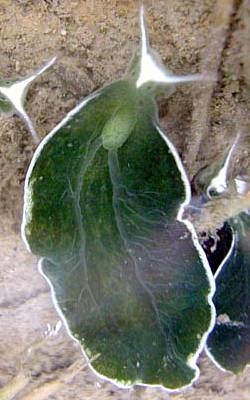
Re: Elysia chilkensis? from Hong Kong
July 3, 2003
From: Bill Rudman
Some of you may have noticed a message I posted earlier today from Ken Ching in which I identified an Elysia from Hong Kong as Elysia chilkensis which Kathe Jensen had previously reported from Hong Kong. Kathe Jensen has quickly informed me that it is actually Elysia leucolegnote which she described from Hong Kong in 1990.
To save complications I have replaced the relevant messages with the correct identifications. For those of you who thought you saw a E. chilkensis message - you did, but its now been replaced.
Thanks Kathe,
Best wishes,
Bill Rudman
